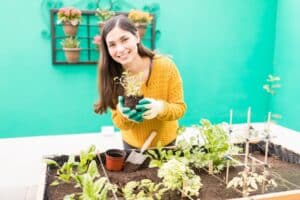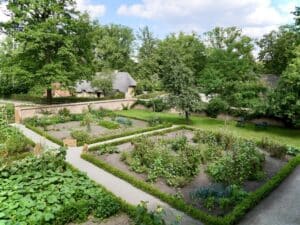From Seed to Sauce: Growing and Cooking with Tomatoes and Basil

There’s something really special about growing your own food. Watching a tiny seed turn into a plant full of tomatoes or basil, and then using what you’ve grown to make a delicious meal, is a great feeling. Tomatoes and basil are not only easy to grow but also super tasty in lots of dishes. In this blog, we’ll show you how to plant, care for, and cook with your very own tomatoes and basil. It’s all about enjoying the freshest flavours right from your garden to your table.
The Basics of Growing Tomatoes and Basil
Choosing the Right Varieties
Before you begin planting, it’s essential to choose the right varieties of tomatoes and basil that suit your taste preferences, climate, and space. For tomatoes, options abound, from sweet cherry tomatoes that burst with flavour to hearty heirlooms that are perfect for slicing. If you prefer making sauces, Roma tomatoes are an excellent choice due to their meaty texture. On the basil front, sweet basil, particularly the Genovese variety, is a classic pairing with tomatoes, while Thai basil offers a more exotic flavour for those who enjoy a bit of spice.
Starting from Seed vs. Seedlings
When it comes to starting your tomato and basil plants, you have two main options: growing from seed or purchasing seedlings. Starting from seed gives you complete control over the growing process and offers a wider variety of choices. It’s a bit more time-consuming but deeply rewarding. To start seeds indoors, you’ll need a good quality seed-starting mix, small pots or seed trays, and a sunny windowsill or grow lights. Sow the seeds about 6-8 weeks before the last expected frost in your area.
On the other hand, if you’re looking for a quicker start, purchasing seedlings from a nursery is a great option. Look for healthy, strong seedlings with vibrant green leaves and sturdy stems. Whether you start from seeds or seedlings, the key to success is giving your young plants the right care as they grow.
Preparing Your Garden or Containers
Tomatoes and basil thrive in well-draining, nutrient-rich soil with plenty of sunlight. Before planting, prepare your garden bed by adding compost or well-rotted manure to enrich the soil. If you’re gardening in containers, choose pots that are at least 30 cm in diameter for tomatoes, as they need plenty of space to develop strong roots. Basil can be grown in slightly smaller pots, but ensure they have good drainage.
When selecting a location, remember that both tomatoes and basil need full sun, meaning at least 6-8 hours of direct sunlight daily. If space is limited, container gardening is a practical solution, allowing you to move the plants to catch the best sun.
Planting and Caring for Tomatoes and Basil
Planting Techniques
Once your garden or containers are ready, it’s time to plant. If you’re transplanting seedlings, carefully remove them from their pots, being mindful not to damage the roots. Plant tomatoes deep, burying part of the stem to encourage a stronger root system. Basil, however, should be planted at the same depth it was growing in its pot.
Tomatoes and basil are excellent companion plants, as they enhance each other’s growth and flavour. Plant them close together, but give each plant enough space to spread out—about 45-60cm between tomato plants and 30cm between basil plants.
Watering, Feeding, and Pruning
Proper watering is crucial for healthy plants. Tomatoes prefer deep, infrequent watering, which encourages the roots to grow deep into the soil. Water them at the base to keep the foliage dry, reducing the risk of disease. Basil needs consistent moisture but be careful not to overwater. The soil should be damp but not waterlogged.
Feeding your plants regularly will keep them vigorous. A balanced fertiliser works well for both tomatoes and basil, applied every 2-4 weeks. Tomatoes may benefit from a boost of calcium to prevent blossom end rot.
Pruning is essential for tomatoes to encourage better fruit production. Remove the “suckers” that grow in the crotch between the stem and a branch to focus the plant’s energy on producing fruit. Basil, on the other hand, should be regularly harvested to prevent it from flowering, which can make the leaves taste bitter.
Dealing with Pests and Diseases
No garden is entirely free from pests and diseases, but with a little vigilance, you can keep them in check. Common tomato pests include aphids, tomato hornworms, and whiteflies. These can be controlled with natural predators like ladybugs or by using organic insecticidal soap.
Basil may attract aphids or Japanese beetles, which can be managed similarly. Fungal diseases like blight or powdery mildew can affect tomatoes, so ensure good air circulation and avoid overhead watering. Basil is generally hardy but can suffer from downy mildew in humid conditions. In both cases, organic fungicides can help if the issue persists.
Harvesting Your Homegrown Tomatoes and Basil
When and How to Harvest Tomatoes
Harvesting tomatoes at the right time ensures the best flavour. For most varieties, the fruit is ready when it’s fully coloured and slightly soft to the touch. Cherry tomatoes are best picked just before they’re fully ripe, as they’ll continue to ripen off the vine. Larger varieties should be picked when they have a uniform colour and a slight give when gently squeezed.
To harvest, use garden scissors or gently twist the fruit from the vine to avoid damaging the plant. Store your tomatoes at room temperature—never in the fridge, as cold temperatures can dull their flavour.
Harvesting and Storing Basil
Basil should be harvested regularly to keep the plant bushy and productive. The best time to harvest is in the morning when the oils in the leaves are most concentrated, but after the dew has dried. Snip off the top leaves, just above a pair of leaves, to encourage the plant to produce more.
If you find yourself with more than enough basil, there are several ways to store it. You can freeze the leaves, either whole or as a pesto, or dry them by hanging small bunches in a cool, dark place.
From Garden to Kitchen: Cooking with Tomatoes and Basil
Simple and Delicious Recipes
Now that you’ve successfully grown and harvested your tomatoes and basil, it’s time to enjoy them in the kitchen. Here are some easy, flavourful recipes that highlight the fresh, homegrown goodness of these ingredients:
Fresh Tomato and Basil Salad
This simple salad is a celebration of fresh flavours. Slice your ripe tomatoes and arrange them on a plate. Top with torn basil leaves, a drizzle of extra virgin olive oil, a splash of balsamic vinegar, and a sprinkle of sea salt. For an added treat, include slices of fresh mozzarella.
Classic Tomato Basil Pasta Sauce
Start by sautéing garlic in olive oil until fragrant. Add chopped tomatoes and let them simmer until they break down into a sauce. Stir in a handful of chopped basil, season with salt and pepper, and serve over your favourite pasta. This sauce can be made in large batches and frozen for later use.
Caprese Salad
Another classic that showcases the partnership of tomatoes and basil. Layer slices of tomato and fresh mozzarella on a plate, then top with basil leaves, olive oil, balsamic reduction, and a pinch of salt. This dish is as beautiful as it is delicious.
Homemade Pizza with Tomato and Basil
Make a simple pizza dough and top it with tomato sauce, fresh mozzarella, and plenty of basil leaves. Bake until the crust is golden and the cheese is bubbly. For an extra burst of flavour, drizzle with olive oil and scatter fresh basil on top just before serving.
Basil Pesto
Pesto is a versatile sauce that can be used on pasta, sandwiches, or as a dip. Blend fresh basil leaves, garlic, pine nuts, Parmesan cheese, and olive oil until smooth. Adjust the consistency with more oil if needed, and season with salt to taste.
Preserving Your Harvest
To extend the enjoyment of your garden’s bounty, consider preserving your tomatoes and basil. Tomatoes can be canned, dried, or frozen. For canning, make a simple sauce or preserve whole tomatoes to use in winter dishes. Basil can be turned into pesto and frozen in small portions, or the leaves can be dried and stored in an airtight container.
The Joy of Growing Your Own Food
The Rewards of Home Gardening
Growing your own tomatoes and basil isn’t just about having fresh ingredients at your fingertips. It’s about the deep satisfaction that comes from nurturing plants and the connection to the food on your plate. Homegrown often tastes superior, not to mention fresher than store-bought, and then there’s nothing quite like announcing at the dinner table that the meal is homemade and homegrown.
Sharing your harvest with friends and family, or even trading with fellow gardeners, is another joy of home gardening. Whether it’s a jar of homemade tomato sauce or a bundle of fresh basil, these gifts are always appreciated.
If you’ve been thinking about starting a garden, now is the perfect time for spring and summer. Tomatoes and basil are fantastic for beginners—they’re easy to grow and incredibly rewarding. Plus, there are plenty of resources out there, from your local nursery to YouTube videos and online communities.
Wrapping Up
At Diaco’s, we believe that growing your own tomatoes and basil is a fun and rewarding experience. Whether you’re making a simple salad, a tasty pasta sauce, or a homemade pizza, nothing beats the flavour of homegrown food. So why not start your own garden? Growing from seed to harvest is something anyone can do, and we’re here to help you along the way.
-
 5, Jul, 2025
5, Jul, 2025How to Create a Mediterranean Style Garden Using Australian Native Plants
Love the look of a Mediterranean style garden but want... -
 13, Jun, 2025
13, Jun, 2025How to Start a Garden Design Project: Step-by-Step Planning Guide for Beginners
At Diaco’s, we know that creating a beautiful garden starts... -
 27, May, 2025
27, May, 2025Smart Garden Layout Ideas: How to Maximise Your Outdoor Space
At Diaco’s, we believe every garden has potential. Whether you’ve...


